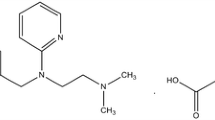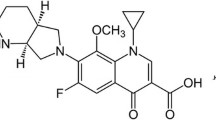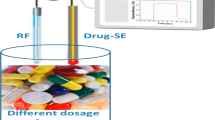Abstract
New potentiometric monitoring devices for trace and fast determination of three imidazole derivatives were presented. The sensing materials were fabricated by the inclusion of imidazolinium phosphomolybdate (Imd/PMA) (sensor I), imidazolinium tetraphenylborate (Imd/TPB) (sensor II), or dibenzo-24-crown-8 (DB24C8) (sensor III) in the plasticized polyvinyl chloride (PVC) matrix. The sensors showed clear enhanced response towards imidazolium [Imd+] ions over the concentration range 4.0 × 10−6–1 × 10−2 mol L−1 at pH 5 with 0.42 μg mL−1 as a detection limit. The selectivity was tested with various inorganic and nitrogenous organic ions. Long life span, fast response, long-term stability, and high reproducibility are shown for the sensors. Method validation for the proposed method was achieved by quantifying the detection limit, linear range, accuracy, precision, repeatability, and between-day variability. It revealed good performance characteristics of the proposed sensors. The applicability of the sensors for analyzing imidazole in urine samples was successfully demonstrated via recovery studies.







Similar content being viewed by others
References
Hochachka PW, Somero GN (2002) Biochemical adaptation: mechanisms and process in physiological evolution. Oxford University Press, New York, p 466
Katritzky AR, Lagowski JM (1984) Structure of five-membered rings with two or more heteroatoms. Comprehensive Heterocyclic Chemistry, 5: 1–38.
Grimmett MR (1997) Imidazole and benzimidazole synthesis. Academic Press, Cambridge
Brown EG (1998) Ring nitrogen and key biomolecules. Kluwer Academic Press, Dordrecht
Pozharskii AF, Soldatenkov AT, Katritzky AR (1997) Heterocycles in life and society. Wiley, Hoboken
Heterocyclic Chemistry, Bath press, 1985
Grosse Y, Baan R, Secretan-Lauby B, El Ghissassi F, Bouvard V, Benbrahim-Tallaa L, Guha N, Islami F, Galichet L, Straif K (2011) Carcinogenicity of chemicals in industrial and consumer products food contaminants and flavorings and water chlorination byproducts. Lancet Oncol 12:328–329
Commission Regulation (EU) No 231/2012 of 9 March 2012 laying down specifications for food additives listed in Annexes II and III to Regulation (EC) No 1333/2008 of the European Parliament and of the Council Text with EEA relevance. Off. J. Eur. Communities: Legis. 2012, L83, 1–295
Commission Directive 2008/128/EC laying down specific purity criteria concerning colours for use in foodstuffs. Off. J. Eur. Communities: Legis. 2008, L6, 20–63
Commission Implementing Regulation (EU) No 872/2012 of 1 October 2012 adopting the list of flavouring substances provided for by Regulation (EC) No 2232/96 of the European Parliament and of the Council, introducing it in Annex I to Regulation (EC) No 1334/2008 of the European Parliament and of the Council and repealing Commission Regulation (EC) No 1565/2000 and Commission Decision 1999/217/EC. Off. J. Eur. Communities: Legis. 2012, 206 L267, 1–161
Garfinkel D, Edsall JT (1958) Raman spectra of amino acids and related compounds. VIII. Raman and infrared spectra of imidazole, 4-methylimidazole and histidine1-3. J Am Chem Soc 80:3807–3812
Alwarthan A, Fattah SA, Zahran NM (1992) Spectrophotometric determination of cephalexin in dosage forms with imidazole reagent. Talanta 39:703–707
Wilks RA, Shingler AJ, Thurman LS, Warner JS (1973) The isolation of 4-methylimidazole from caramel color and its determination by thin-layer and gas-liquid chromatography. J Chromat A 87:411–418
Fuchs G, Sundell S (1975) Quantitative determination of 4-methylimidazole as 1-acetyl derivative in caramel color by gas-liquid chromatography. J Agri Food Chem 23:120–122
Wu P, Zhang L, Wang L, Zhang J, Tan Y, Tang J, Ma B, Pan X, Jiang W (2014) Simultaneous determination of ethyl carbamate and 4-(5-)methylimidazole in yellow rice wine and soy sauce by gas chromatography with mass spectrometry. J Sep Sci 37:2172–2176
Schlee C, Markova M, Schrank J, Laplagne F, Schneider R, Lachenmeier DW (2013) Determination of 2-methylimidazole, 4-methylimidazole and 2-acetyl-4- (1,2,3,4-tetrahydroxybutyl) imidazole in caramel colors and cola using LC/MS/MS. J Chromatogr B 927:223–226
Karangwa E, Mitchell GE Jr, Tucker RE (1990) High-performance liquid chromatographic determination of 4-methylimidazole in sheep plasma and in ammoniated tall fescue hay. J Chromat B: Biomedical Sci Appli 532:105–113
Zhu Y, Ren H, Wei Y, Bie Z, Ji L (2015) Determination of imidazole, 4-methylimidazole, and 2-methylimidazole in cigarette additives by ultra-high performance liquid chromatography. Anal Lett 48:2708–2714
Moore-Testa P, Saint-Jalm Y, Testa A (1984) Identification and determination of imidazole derivatives in cigarette smoke. J Chromat A 290:263–274
Charlton AJ, Jones A (2007) Determination of imidazole and triazole fungicide residues in honeybees using gas chromatography–mass spectrometry. J Chromat A 1141:117–122
Yamaguchi H, Masuda T (2011) Determination of 4 (5)-methylimidazole in soy sauce and other foods by LC-MS/MS after solid-phase extraction. J Agric Food Chem 59:9770–9775
Raters M, Elsinghorst PW, Goetze S, Matissek R (2015) Determination of 2-methylimidazole, 4-methylimidazole and 2-acetyl-4-(1,2,3,4tetrahydroxybutyl) imidazole in liquorice using high performance liquid chromatography-tandem mass spectrometry stable-isotope dilution analysis. J Agric Food Chem 63:5930–5934
Petruci JFDS, Pereira EA, Cardoso AA (2013) Determination of 2-methylimidazole and 4-methylimidazole in caramel colors by capillary electrophoresis. J Agric Food Chem 61:2263–2267
Pihel K, Hsielh S, Jorgenson JW, Wightman RM (1995) Electrochemical detection of histamine and 5-hydroxytryptamine at isolated mast cells. Anal Chem 1995(67):4514–4521
El-Naby EH, Kamel AH (2015) Potential transducers based man-tailored biomimetic sensors for selective recognition of dextromethorphan as an antitussive drug. Mat Sci Eng C 54:217–224
Kamel AH (2015) Potentiometric transducer based on a Mn(II) [2-formylquinoline thiosemicarbazone] complex for static and hydrodynamic assessment of azides. Talanta 144:1085–1090
Kamel AH, Khalifa ME, Elgendy FA, Abd El-Maksoud SA (2014) Fabrication of novel sensors based on a newly synthesized macrocyclic pyridine derivatives ionophores for potentiometric monitoring of copper. Anal Met 6:7814–7822
Janjali MR, Abdi M, Pirelahi H, Mouradzadegun A, Sohrabi MR (2003) Novel imidazole PVC-based sensor based on a thiopyrilium compound. Anal Sci 19:1387–1390
Ganjali MR, Abdi M, Pirelahi H, Mouradzadegun A, Sohrabi MR (2004) Novel imidazole PVC-based membrane sensor based on 4-methyl-2,6-diphenylthiopyrylium. Anal Lett 37:179–190
Hassan SSM, Kamel AH, Abd El-Naby H (2014) Novel potentiometric sensors for batch and continuous monitoring of alizarin red S dye and their application for aluminum assessment. J Chin Chem Soc 61:295–302
Kamel AH, Hassan AME (2016) Solid contact potentiometric sensors based on host-tailored molecularly imprinted polymers for creatine assessment. Int J Electrochem Sci 11:8938–8949
Hassan SSM, Kamel AH, Abd El-Naby H (2013) New potentiometric sensors based on selective recognition sites for determination of ephedrine in some pharmaceuticals and biological fluids. Talanta 103:330–336
Hassan SSM, Badr IHA, Kamel AH, Mohamed MS (2013) New potentiometric sensors for picrate determination using flow-through system: application to kinetic assessment of Se(IV). Electroanalysis 25:793–801
Kamel AH, Khalifa ME, Elgendy FA, Abd El-Maksoud SA (2014) New plastic membrane sensors for selective determination of pyridine as a hazardous pollutant: validation and applications to flow injection analysis. Int J Electrochem Sci 9:1663–1677
Umezawa Y, Buhlmann P, Umezawa K, Tohda K, Amemiya S (2000) Potentiometric selectivity coefficients of ion-selective electrodes. Part I. Inorganic cations (technical report). Pure Appl Chem 72:1851–2082
Cremonesi P, Galimberti G, Coletti O, Sportoletti G (1984) High-performance liquid chromatograic determination of imidazole in biological fluids. J Chromatogr 308:310–315
Author information
Authors and Affiliations
Corresponding author
Rights and permissions
About this article
Cite this article
Kamel, A.H., Argig, A.A.A. Automatic potentiometric system for quantification of three imidazole derivatives based on new polymeric PVC membrane sensors. Ionics 23, 2201–2211 (2017). https://doi.org/10.1007/s11581-017-2029-6
Received:
Revised:
Accepted:
Published:
Issue Date:
DOI: https://doi.org/10.1007/s11581-017-2029-6




